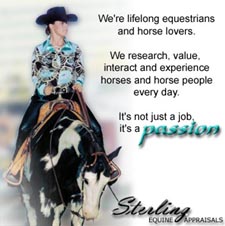In general, the market for double registered (AQHA/APHA) horses is strong. Demand for DR horses is strong, but quality has to be present. Remember the old adage "You don't ride the papers."
Recently a question was posed about the market for a double registered Quarter Horse / Paint Horse weanling colt. The qualifying white was his facial marking, and he has Regular Registry papers with APHA. This particular colt has a sire who is no longer of popular blood, and his dam is "well-bred" but unshown. Even if she has a fantastic pedigree, since this is her first foal, few people will be inclined to reach deep into their pocketbooks.
Most novice or new buyers don't know enough to specifically look for a double registered horse as a defining characteristic. (And I am hopeful that most novices are not out looking for a weanling colt anyway). Additionally, many buyers of all levels compete in events not sanctioned by a particular breed association, like rodeo and jumping. In these instances, registration is simply an added bonus, not a requirement.
Double registered riding horses and prospects are often sought out my a more experienced buyer who is interested in showing in either or both breed associations. Often, they have the assistance of a trainer or agent when making a purchase. With that in mind, a double registered horse must be of above average quality to attract this more knowledgeable buyer.
Generally, the market for colts (being sold as stallion prospects) is a different group of buyers than the market for geldings (being sold as show prospects). Without a powerful pedigree behind him, it's my opinion that this colt should be gelded.
In this past year, under pedigree and conditions similar to this colt's, I have seen average double registered prospects sell for $3,500 to $6,500. I have seen DRs that are started under saddle sell for up to $15k. And, I know of a young DR who is showing successfully in both associations that just changed hands for $30k. Proven or exceptional horses naturally have sold for more.
Breeders might want to consider the amount of money it takes to keep, maintain, train, and eventually show one, to get to the various price points. And, they should also consider what they think the market will do (remain, fall farther, rise) before setting a price and determining when they will sell.
Breeders will continue to demand DRs backed by excellent pedigrees to expand the marketability of resulting foals within several different market segments. As show prospects, pedigree is less important than the double registered horse's talent, movement and temperment - the same characteristics anyone would look for in a show horse. Once proven successful in competition, the DR can potentially make its own bloodline more relevant and therefore more valuable.
I would love to hear your thoughts on this...
Friday, December 17, 2010
Double Registered Market is Strong (AQHA/APHA)
Tuesday, September 29, 2009
The value of unsoundness
As appraisers, we are often asked to appraise horses that are unsound in some way. With age, competition, and training, horses are expected to develop "issues." Some of these can be treated with minor maintenance, and others require more invasive efforts to continue a horse's competitive career.
It would be uncommon for an aged show horse to withstand the rigors of a competitive discipline without some maintenance (supplements, cold hosing, hock injections are a few examples) and even more unusual for a show ring veteran to be “completely sound.” I would be shocked to find a veterinarian to declare one as such.
Many owners are choosing to donate their serviceably sound horses to equestrian programs and non-profit organizations. These groups benefit from the time constrains and “it’s disposable” attitude of the competitive horse world. Horses with treatable injuries or which require maintenance are welcome additions to most programs. For a little TLC and some (often donated) veterinary service, they can add a talented, well trained mount to their stable.
If a horse is unsound with a poor prognosis for recovery, it may be more difficult to donate. A non-profit may not be willing to take on the burden of caring for a horse they cannot ride, but a school with a veterinary program may relish the opportunity to give students a real-life example to treat. If you are considering donation, research the options carefully. Some programs will notify the original owner if the horse is no longer suitable for their purpose; however, many just sell the horse without notification. And, vet schools may try untested treatments or even practice euthanasia. Know what your horse might experience, and determine what you can live with, before making the final decision.
In summary, we regularly appraise horses that have suffered injuries or experienced soundness issues. The value is determined based on the horse as perfect, then subtracting for the type of care they require and any the prospects for their future. A $100k horse which develops ringbone may be worth less to a buyer than one who develops navicular, because the latter is often managed with improved shoeing and drug therapy.


